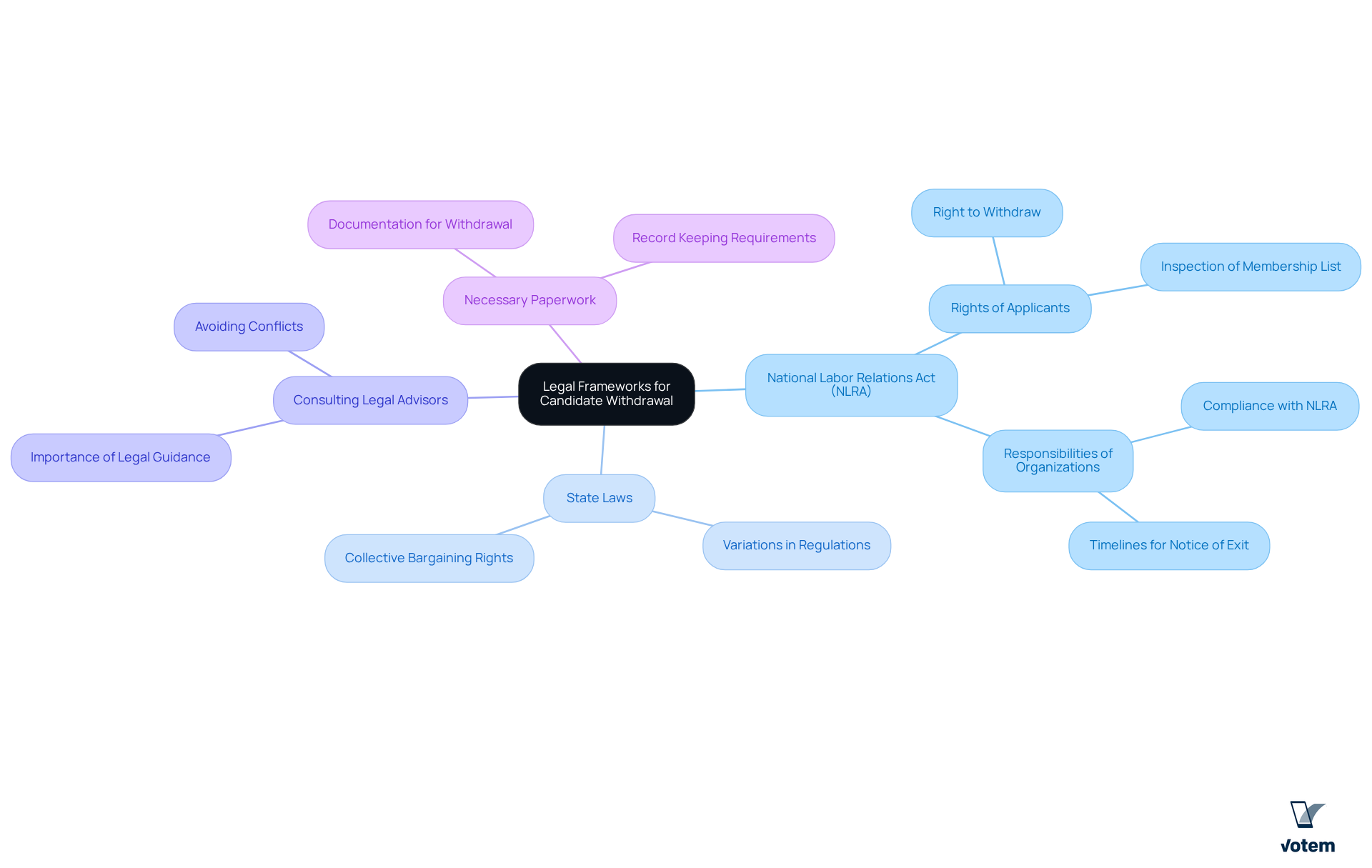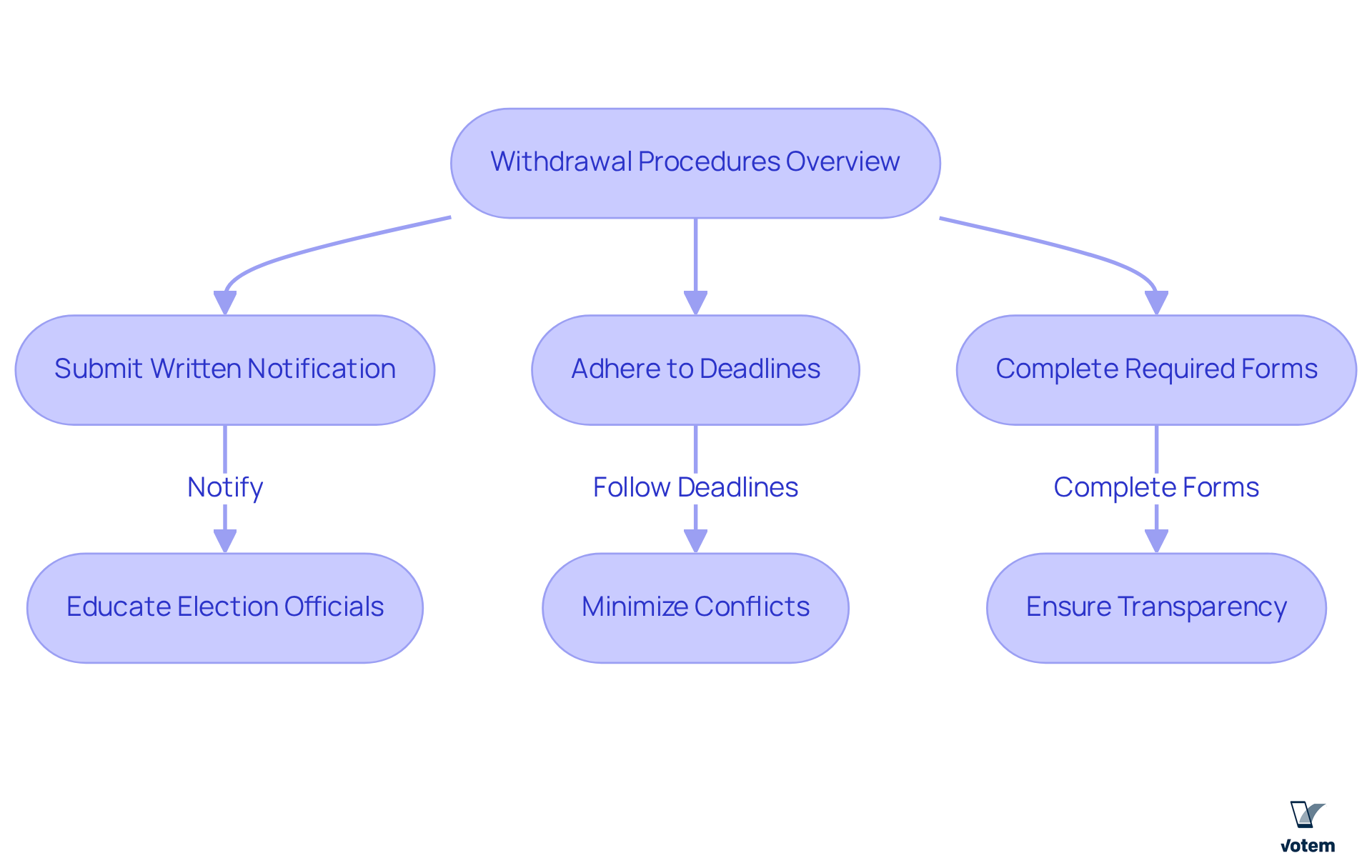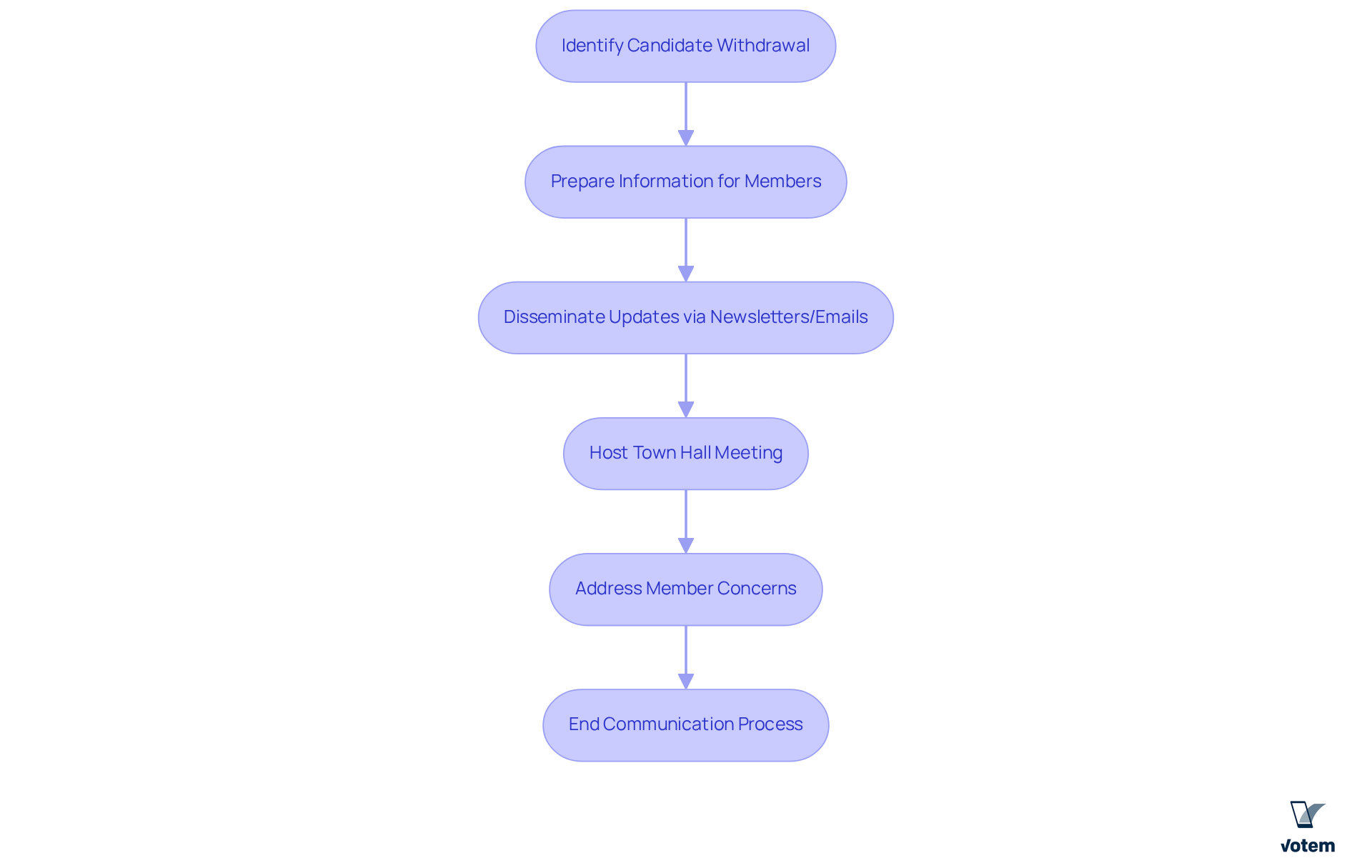Overview
Managing candidate withdrawal in unions requires a comprehensive understanding of legal frameworks, effective withdrawal procedures, and transparent communication with union members. By adhering to legal regulations and implementing standardized processes for candidate removal, union leadership can significantly reduce conflicts. Furthermore, proactive communication fosters member engagement, contributing to a more stable electoral environment.
To capture the attention of union leaders, it is essential to recognize the challenges they face in this complex landscape. The implementation of best practices not only mitigates potential issues but also enhances the overall electoral process. By focusing on these key areas, unions can cultivate a more engaged membership and a smoother electoral experience.
In addition, the importance of maintaining clear communication cannot be overstated. Regular updates and open dialogues with union members about withdrawal procedures can help build trust and minimize misunderstandings. This approach not only addresses immediate concerns but also lays the groundwork for future electoral stability.
Ultimately, the combination of legal adherence, standardized processes, and proactive communication serves as a foundation for effective candidate withdrawal management. Union leadership is encouraged to take these insights and implement them within their organizations, ensuring a more organized and conflict-free electoral environment.
Introduction
Navigating the complexities of candidate withdrawal in unions is a crucial yet often overlooked aspect of labor organization management. This process is not merely procedural; it is foundational to ensuring that the rights of candidates are protected and that unions comply with legal regulations. Such compliance fosters a fair electoral environment, which is essential for maintaining member trust.
However, many unions grapple with the challenge of implementing effective withdrawal procedures. They often struggle to maintain transparent communication with their members, leading to potential disruptions during elections.
How can unions streamline these processes to minimize disruptions and enhance member trust during elections?
Understand Legal Frameworks for Candidate Withdrawal
Organizations must thoroughly comprehend the legal structures regulating candidate withdrawal, as these can vary significantly based on jurisdiction and specific group regulations. Central to these regulations is the National Labor Relations Act (NLRA), alongside pertinent state laws, which delineate the rights and responsibilities of both applicants and labor organizations. Understanding these regulations is essential for navigating the complexities of nominee exits and candidate withdrawal, ensuring that organizations uphold individuals’ rights while adhering to compliance standards.
For instance, associations must be acutely aware of the timelines for notice of exit and the essential paperwork required for a legitimate departure. Furthermore, consulting with legal advisors can provide invaluable insights, helping organizations to avert potential conflicts or complaints that may arise from the removal of participants.

Implement Effective Withdrawal Procedures
To execute efficient exit procedures, unions must establish a uniform system that provides clear instructions for candidate withdrawal from elections. This procedure should incorporate critical steps, including:
- The submission of a written notification of removal
- Adherence to specified deadlines
- The completion of any required forms
Educating election officials about these procedures is essential to ensure consistency and transparency throughout the operation. For instance, an organization could designate a specific email address for removal notifications, facilitating straightforward tracking and documentation.
Studies indicate that organizations with standardized withdrawal procedures experience reduced candidate withdrawal rates, fostering a more stable electoral environment. By clearly outlining these processes, associations can minimize conflicts and ensure that all applicants are treated equitably. Furthermore, it is vital for organizations to communicate election regulations and processes to all applicants as early as possible, ensuring that everyone is informed and prepared.

Communicate Transparently with Union Members
Unions must prioritize clear communication with their members regarding the removal of nominees. This objective can be achieved through regular updates via newsletters, emails, or association meetings. When there is a candidate withdrawal, it is crucial to inform members promptly, detailing the reasons for the departure and any implications for the election process.
Furthermore, worker organizations should develop FAQs or informational resources to address common inquiries and concerns. For instance, an association might host a town hall meeting to discuss candidate withdrawal and its effects, allowing members to express their views and ask questions. By fostering open communication, associations can bolster member trust and engagement during the electoral period.
Statistics reveal that 52% of executives believe the primary reason members do not renew their membership is due to a lack of engagement, emphasizing the necessity of proactive communication. As highlighted, “Transparency is essential to building trust and confidence while legitimizing the electoral process.”
Additionally, unions must be vigilant about common communication pitfalls regarding candidate withdrawal, such as failing to provide timely updates or neglecting member concerns, as these can erode trust and engagement.

Conclusion
Effectively managing candidate withdrawal in unions is essential for preserving the integrity of the electoral process and ensuring adherence to legal standards. By implementing best practices, unions can adeptly navigate the complexities of candidate exits, fostering a transparent and equitable environment for all members involved.
Key strategies for managing candidate withdrawal include:
- A comprehensive understanding of legal frameworks
- The establishment of effective withdrawal procedures
- The necessity of transparent communication with union members
Informing all stakeholders of their rights and responsibilities minimizes conflicts and enhances member engagement. Moreover, standardized procedures not only decrease withdrawal rates but also promote a fair electoral atmosphere.
The significance of proactive communication cannot be overstated. By encouraging open dialogue about candidate withdrawals, unions can cultivate trust and confidence among their members, thereby legitimizing the electoral process. As unions strive to uphold the democratic principles of their organizations, embracing these best practices will ensure a more stable and participatory environment for future elections.
Frequently Asked Questions
What is the importance of understanding legal frameworks for candidate withdrawal?
Understanding legal frameworks is crucial for organizations as these regulations vary by jurisdiction and specific group rules. They help delineate the rights and responsibilities of both applicants and labor organizations.
What key legislation governs candidate withdrawal?
The National Labor Relations Act (NLRA) is central to the regulations governing candidate withdrawal, along with relevant state laws.
Why is it essential for organizations to be aware of timelines and paperwork related to candidate withdrawal?
Organizations must be aware of the timelines for notice of exit and the necessary paperwork to ensure a legitimate departure, which helps uphold individuals’ rights and adhere to compliance standards.
How can consulting with legal advisors benefit organizations regarding candidate withdrawal?
Consulting with legal advisors can provide invaluable insights, helping organizations avoid potential conflicts or complaints that may arise from the removal of participants.
List of Sources
- Understand Legal Frameworks for Candidate Withdrawal
- Workers want unions, but the latest data point to obstacles in their path: Private-sector unionization rose by more than a quarter million in 2023, while unionization in state and local governments fell (https://epi.org/publication/union-membership-data)
- Conducting Local Union Officer Elections (https://dol.gov/agencies/olms/compliance-assistance/publications/guide-for-conducting-local-union-officer-elections)
- Implement Effective Withdrawal Procedures
- Conducting Local Union Officer Elections (https://dol.gov/agencies/olms/compliance-assistance/publications/guide-for-conducting-local-union-officer-elections)
- Communicate Transparently with Union Members
- Improving Trade Union Election Transparency – ElectionBuddy (https://electionbuddy.com/blog/2024/06/24/improving-trade-union-election-transparency)
- How to Measure Member Engagement (https://marketinggeneral.com/blog/how-to-measure-member-engagement)

